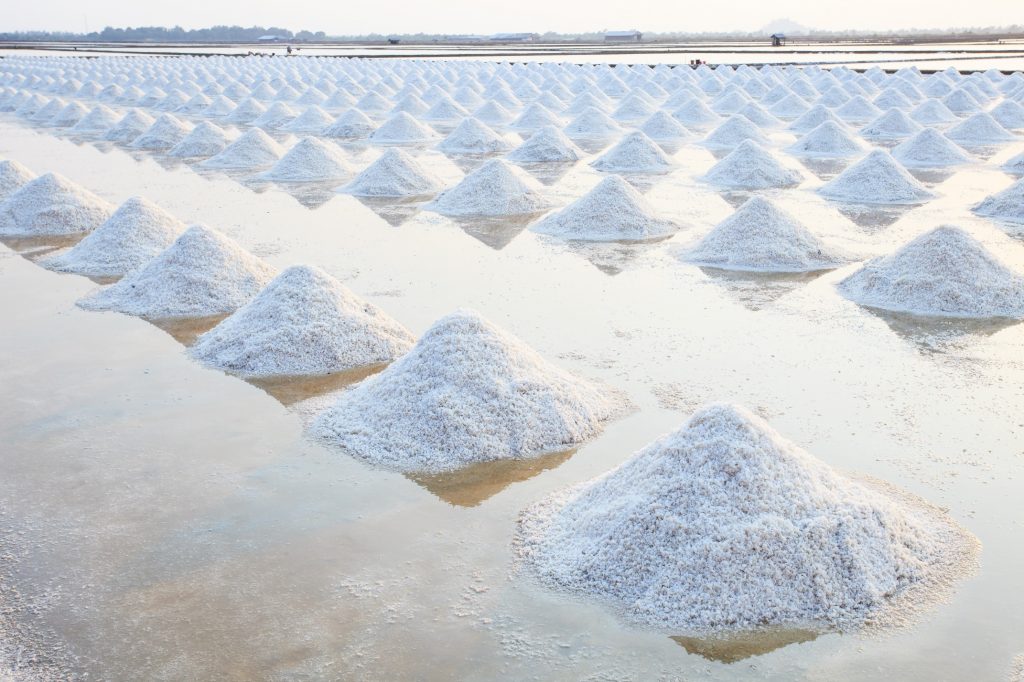Initiatives to lower the sodium content in the food supply come in the form of mandatory or voluntary targets, which are a critical step to reducing dietary sodium intakes1. As the world focuses more on sustainable diets, we can expect dietary sodium intake targets to become more important and prevalent in the coming years. In this article, we review:
-
- Sodium’s role in health
- Tax and legislation initiatives on sodium reduction being enacted globally, and their impact
- Voluntary initiatives from food industry and impact on sodium intake
- What to expect in the future
Effects of excess sodium intake on health
Cardiovascular diseases (CVD) account for most non-communicable deaths (NCDs) globally1, which equates to 17.9 million people annually 2. Of these deaths, an estimated 1.89 million each year is associated with excessive intake of sodium in Europe3, which is a major driver of high blood pressure in many countries4, which is the leading risk factor for CVD5,6. Salt is the main source of sodium in foods7, therefore reducing salt intake can naturally translate into a lower sodium intake, which is beneficial for health4,8, and is associated with reduced cardiovascular events1. However, sodium isn’t all bad! The human body requires a small amount of sodium for critical body function such as muscle contraction and relaxation, conduction of nerve impulses, and regulation of body fluids7. Unfortunately, our intake far exceeds the amount required by the human body and, hence, has a negative impact on health3.
The global average dietary sodium intake in adults is 4,310mg/day (10.78g salt/day) which is more than double the recommendation advised by World Health Organisation (WHO) (2000mg sodium/day = 5g salt/day)9,10. In general, daily sodium intake targets range between 2,000mg and 2,400mg per day (5 – 6g) across the globe9,11-13. Alarmingly, reports from international organisations reveal that the Middle East has extremely high rates of salt consumption, with an average per capita consumption of more than 12 g/ day14.
According to the UK National Diet & Nutrition Survey (NDNS), the main contributors of dietary salt are bread, cheese, and processed meat products15. This is similar for Europe, with a large proportion of salt intake coming from foods that don’t necessarily taste salty such as potato products and tinned produce16. On the other hand, sources of dietary sodium have been shown to differ between high-income countries (HICs) and low- and middle-income countries (LMICs)17. For instance, in Southeast Asia, manufactured and processed foods provide 80% of the dietary salt intake in HICs, whereas most of the consumed salt in LMICs is added during food preparation and cooking and/or discretionary table salt17,18. It is important to bear in mind that, in general, consumption of processed foods is still relatively low in South Asian countries. A study conducted in South India identified key food sources of sodium were pulses (29.7%), rice-based dishes (27%), and vegetables (16.7%)19.
What actions are being taken to lower sodium intake globally?

Salt farm in Thailand
Implementing highly cost-effective sodium reduction initiatives could potentially save an estimated seven million lives globally by 2030, according to the WHO20. Many countries have implemented salt reduction targets for commonly consumed foods as part of a strategy to reduce salt intakes. In 2013, the WHO Member States adopted a voluntary global target of 30% reduction in mean population salt intake by 202521. In 2023, the WHO published a global report on sodium intake reduction that details countries which have adopted and implemented sodium reduction policies6.
Santos et al22 conducted a comprehensive review to identify national salt reduction initiatives around the world, and to quantify progress. In summary, although there was an increase in the number of salt reduction initiatives around the world since 2014, efforts must be urgently accelerated and replicated in other countries with more rigorous monitoring and evaluation of strategies needed to achieve the salt reduction target.
Table 1. National sodium/salt reduction initiatives by WHO region22
South-East Asia
To align with the WHO global sodium reduction target, in 2013, the WHO South-East Asia countries set an intermediate regional target of 10% reduction in mean salt intake over the next 5 years10.
Europe & UK
Many countries in Europe either have mandatory and/or voluntary salt reduction initiatives such as maximum permitted salt levels in foods and reformulation programs. Policies include strategies such as taxes on high-salt food (Hungary), mandatory high-salt content labels (Finland), and targets for reformulation and close monitoring of the food supply (UK)23.
Eastern Mediterranean
The Eastern Mediterranean Region, which includes 22 countries and a population of approximately 580 million people, is a region that has a high burden of CVD17,24. National sodium/salt reduction strategies have been identified in Bahrain, Egypt, Iran, Jordan, Saudi Arabia, Kuwait, Lebanon, Morocco, Oman, Palestine, Qatar, Tunisia, and the UAE17. The least common initiative was taxation on foods and beverages, whereas the most common strategy was reformulation (100%), followed by consumer education (77%), initiatives in specific settings (54%), and front of pack labelling (46%). However, only 27% of Eastern Mediterranean countries monitored activities, and impact evaluations are lacking24.
Taxes and legislation
Taxing high salt products
Case Study – Europe

In 2011, Hungary implemented a tax called Public Health Product Tax (PHPT) on packaged foods that contain high levels of salt such as salty snacks and condiments. The aim of introducing taxes is to reduce the consumption of food products that are not beneficial to public health25. However, it is not easy to prove causality between the implementation of a nutrient tax and a reduction in consumption of that specific nutrient. For Hungary, an evaluation was conducted after the introduction of the PHPT to monitor its impact on the population. Unfortunately, the consumption of taxed products by the adult population did not decrease, thus the salt tax had a minimal impact on Hungarian consumers behaviours26.
Establishing mandatory upper limits on salt content of foods
Americas
On December 6, 2023, the Ministry of Health of Colombia issued Resolution 2056 which amended their “sodium rule”. This amendment allows US exporters to use self-declarations to certify compliance with Colombia’s maximum sodium levels in processed products, which will help facilitate the trade of processed products to Colombia27.
Europe & UK
European countries, including Belgium, Bulgaria, France, Greece, Netherlands, and Portugal, have implemented mandatory maximum salt targets on products with a generally high salt content. The main products of focus are those that significantly contribute to dietary sodium intakes. The United Kingdom is often viewed by other countries as a good example for addressing an issue in public health28. It implemented a successful voluntary salt reduction initiative, and now the government legislated to restrict the promotion, location and advertising of products deemed high in fat, sugar, and/or salt (HFSS)29.
Warning labels on high salt foods
Across the globe, many countries use front of pack nutrition labels or warning labels that highlight the content of energy and usually these four nutrients – fat, saturated fat, sugar, and salt in foods and beverages. It is widely accepted that one of the most effective ways to reduce sodium intake at a population level is through lowering the sodium content of foods that are consumed frequently. Engaging industry on a voluntary basis to reformulate products high in salt is a key strategy to achieve success23. Many countries have established voluntary industry-led initiatives with category-specific salt targets for a wide range of food products.
Europe & UK
The EU is planning to propose a unified front-of-pack labelling scheme for all member states in 2025. European food industry and retailers show Reference Intakes (RI) on the front of product packaging, where the content of the above mentioned are displayed along with the daily RI for energy and for the four nutrients per portion30. In addition, the energy value is also expressed per 100g/100ml. In recent years many countries have adopted similar front-of-pack labels displaying information on sodium (or salt). For instance, in mainland Europe, several countries have implemented the Nutri-Score labelling scheme which grades the nutritional value of foods from A to E30. In December 2023, Santé Publique published their latest technical document for Nutri-Score to enable food industry to adopt the revised Nutri-Score algorithms for food and beverages31.
In Finland, numerous activities have been undertaken to reduce salt, in particular voluntary initiatives, and compulsory front-of-pack warning labels. Warning labels are required if a specific product contains sugar or salt above a defined threshold. For example, foods that are high in salt are required to carry a “high salt content” warning32. Interestingly, since their introduction, the average sodium content in food products in Finland has decreased by 20-25%32.
Americas and Canada
Many countries in Latin America such as Chile, Mexico, Peru, Uruguay, and soon Brazil, have adopted front-of-pack black warning labels that indicate if a product is high in calories, fat, sugar, and salt30,33 (Figure 1).

Figure 1. Example of front-of-pack warning labels used in Chile. From left to right: High in Sugar, High in Sodium, High in Calories, High in Saturated Fat. At the bottom of each label it states Ministry of Health.30,33
In October 2021, the US Food and Drug Administration published new voluntary sodium reduction goals for the food and beverage industry34. Due to pressures to reduce sodium intake, the targets are only for 2.5 years compared with those issued previously. The strategy supports sodium reduction already achieved by industry, provides targets for defining and measuring progress, and provides companies with the flexibility and time to meet these targets. Furthermore, the US is considering the use of front-of-pack labelling. In 2023, the US FDA conducted tests to gain consumer’s understanding of both black/white and colour schemes through various focus groups. Interestingly, Canada introduced a front-of-pack nutrition symbol in 2023 that is required on foods high in sugar, sodium and/or saturated fat.
South-East Asia
In most South Asian countries, salt reduction initiatives are still in the planning phase and are yet to be fully implemented, with outcomes not evaluated or reported10. Scaling up community-wide salt reduction strategies in this region is imperative for reducing salt intakes.
From a public health perspective, voluntary industry initiatives can be more effective, as they may be more achievable than government measures which can be hampered by pressure from interest groups, political gridlock, and bureaucratic inertia. They may also achieve public health objectives quicker, more efficiently and less intrusively than governmental regulation.
From an industry perspective, there are many positives with engaging in nutritional improvement of products, such as public health responsibility, creating positive publicity for the brand, goodwill among stakeholders and preventing binding government regulation and fiscal measures. Product reformulation has large potential effects on the quality of the diet and has the potential to improve population health16. One primary hurdle is that reformulation can alter the sensory attributes of food products and influence consumer liking. However, there is evidence that consumers do not detect gradual decreases in the salt content of foods when slowly reduced over time35.
Examples of successful industry-government partnerships for salt reduction
Community-based salt reduction programs have been conducted in many parts of the world, resulting in reduced salt intake, increased awareness and lowering of BP10. Of all the WHO 194 Member States, 79% (154) have committed a policy towards sodium reduction and these commitments are usually included in national nutrition plans (n = 82), non-communicable disease plans (n = 94) or health sector plans (n = 40)6. In 2023, the WHO published their global report on sodium intake reduction providing detailed examples of sodium intake reduction initiatives across their Member States6.
Western Pacific
A community-based Eat Less Salt intervention in Vietnam decreased community salt intake from 21.5 to 20.4 g/day together with reduction in systolic blood pressure by 5.93 mmHg and diastolic blood pressure by 4.86 mmHg between baseline and follow-up of 1-year intervention10. A similar project in Australia demonstrated a mean salt intake reduction from 8.8 to 8 g/day over a 3-year period. A study in Japan found significant reduction in community salt intake, and a corresponding reduction in BP10.
Europe & UK
Similarly, a research study conducted in Portugal reported a significant reduction in community salt intake, and a corresponding reduction in BP10. Many EU governments in countries including Austria, Belgium, Bulgaria, Croatia, Czech Republic, Denmark, Finland, France, Greece, Hungary, Italy, Lithuania, Netherlands, Poland, and Spain have proposed a collaborative approach with industries on setting voluntary salt targets. In Ireland, a salt reduction program was run over ten years from 2003 to 2013 which led to a reduction in adult salt intake by 1.1g36. In 2021, the Irish Government published their ambitious ‘Reformulation Roadmap’ with 2025 targets for reducing calories (20%), saturated fat (10%), salt (10%) and sugar (20%) in products that contribute to the most intake of these nutrients37.
Recently, the UK released the fifth sets of voluntary salt reduction targets. The UK’s gradual salt reduction program has been successful in reducing population-level salt intake: it achieved an overall reduced salt intake of 1 g/day in the adult population, reducing adult average sodium intake from 3,752 mg/day (9.38 g/day) in 2000 to 3,352 (8.38 g/day) in 201838. This is a great step forward for public health despite the intake still being considerably higher than the UK recommended intake of 2,400g/day.
Conclusion
Many countries have taken and will continue to take actions to reduce population sodium intake. High sodium intake is associated with not only increased blood pressure but also risk of CVD. Global sodium consumption is too high, so reducing intake will significantly improve public health. For this reason, the sodium levels in products will continue to be scrutinised and the pressure on industry to reformulate products will continually increase. The role of salt is essential in the preservation, flavour, and structure of food products; therefore, it is essential that governments and food industry collaborate to educate consumers, invest in new technologies and develop innovative reformulation methods and practices.
This article was originally published on 13 October 2021. It was updated 27 February 2024 to reflect new information.
Contributors:
-
References
1. Vaduganathan M, et al. (2022). The Global Burden of Cardiovascular Diseases and Risk: A Compass for Future Health. J Am Coll Cardiol. 2022 Dec, 80 (25) 2361–2371. https://doi.org/10.1016/j.jacc.2022.11.005
2. World Health Organisation. Cardiovascular diseases [Last accessed January 2024]
3. World Health Organisation Europe. (2020). Document number: WHO/EURO:2020-1989-41744-57142 Accelerating salt reduction in Europe. [Last accessed January 2024]
4. Bibbins-Domingo K, et al. (2010). Projected effect of dietary salt reductions on future cardiovascular disease. N Eng J Med 362: 590-599.
5. Razo C, et al. (2022). Effects of elevated systolic blood pressure on ischemic heart disease: a Burden of Proof study/ Natl. Med. 28: 2056-2065.
6. World Health Organisation. (2023). Global report on sodium intake reduction. ISBN: 978-92-4-006998-5 WHO global report on sodium intake reduction [Last accessed January 2024]
7. Harvard TH Chan School of Public Health – The Nutrition Source. (2024). Salt and Sodium. https://www.hsph.harvard.edu/nutritionsource/salt-and-sodium/ [Last access January, 2024]
8. Institute of Medicine (US) Committee on Strategies to Reduce Sodium Intake. (2010). Strategies to Reduce Sodium Intake in the United States. Editors: Jane E Henney, Christine L Taylor, and Caitlin S Boon. Washington (DC): National Academies Press (US); ISBN-13: 978-0-309-14805-4ISBN-13: 978-0-309-14806-1. https://pubmed.ncbi.nlm.nih.gov/21210559/ [Last accessed January 2024]
9. World Health Organisation. (2023). Sodium reduction. [Last accessed January 2024]
10. Ghimire K, et al. (2021). Salt intake and salt-reduction strategies in South Asia: From evidence to action. J Clin Hypertens 23:1815-1829. doi: 10.1111/jch.14365.
11. NHS. (2023). Salt in your diet. [Last accessed January 2024]
12. Irish Heart Foundation. (2023). Taking control of salt. https://irishheart.ie/how-to-keep-your-heart-healthy/salt/. [Last accessed January 2024]
13. American Heart Association. (2024). How much sodium should I eat per day?. [Last accessed January 2024]
14. Saudi Food and Drug Authority. (2023). Saudi Arabia Among List of Countries to Reduce Salt Consumption. [Last accessed January 2024]
15. Public Health England. (2020). National Diet and Nutrition Survey Assessment of salt intake from urinary sodium in adults (aged 19 to 64 years) in England, 2018 to 2019. Assessment of salt intake from urinary sodium in adults. [Last accessed January 2024]
16. Von Philipsborn P, et al. (2018). Voluntary industry initiatives to promote healthy diets: a case study on a major European food retailer. Public Health Nutrition 21: 3469-3476.
17. Al-Jawaldeh A, et al. (2021). Salt Reduction Initiatives in the Eastern Mediterranean Region and Evaluation of Progress towards the 2025 Global Target: A Systematic Review. Nutrients 13: 2676. doi: 10.3390/nu13082676.
18. Shahriarpour Z et al. (2020). Adherence to the dietary approaches to stop hypertension (DASH) dietary pattern and osteoporosis risk in postmenopausal Iranian women. Osteoporosis Int. 31: 2179–2188.
19. Ravi S, et al. (2016). Sodium intake, blood pressure, and dietary sources of sodium in an adult South Indian population. Ann Glob Health. 82 :234-242.
20. World Health Organisation. (2023). Massive efforts needed to reduce salt intake and protect lives. [Last accessed January 2024].
21. World Health Organisation. (2024). Reducing population sodium/salt intake. [Last accessed January 2024].
22. Santos JA, et al. (2021). A Systematic Review of Salt Reduction Initiatives Around the World: A Midterm Evaluation of Progress Towards the 2025 Global Non-Communicable Diseases Salt Reduction Target. Advances in Nutrition 12, 1768-1780., ISSN 2161-8313. https://doi.org/10.1093/advances/nmab008. [Last accessed January 2024].
23. European Commission. (2014). Survey on Members States’ Implementation of the EU Salt Reduction Framework. ISBN: 978-92-79-28771-8. Doi: 10.2772/50212. [Last accessed January 2024].
24. World Development Indicators Database. (2015).Gross National Income per Capita, Atlas Method and PPP. https://databank.worldbank.org/data/download/GNIPC.pdf. [Last accessed January 2024].
25. Wilson N. (2004). Salt tax could reduce population’s salt intake. Brit. Med. J. (Clinical research ed.,) 329,7471: 918.
26. Csákvári T, et al. (2023). Assessing the impact of Hungary’s public health product tax: an interrupted time series analysis. Cent Eur J Public Health. 31:43-49. doi: 10.21101/cejph.a7284. PMID: 37086420.
27. USDA. (2023). Colombia Amends Sodium Regulation. [Last accessed January 2024].
28. He FJ,et al. (2014). Salt reduction in the United Kingdom: a successful experiment in public health. J Hum. Hyp. 28: 345-52.
29. O’Keeffe P. (2021). Kerry Health and Nutrition Institute (KHNI).
Restrictions on Advertising Unhealthy Foods – A Guide to Navigate Upcoming UK HFSS Legislation. [Last accessed January 2024].30. Temple N. (2020). Front-of-package food labels: A narrative review. Appetite 144: 104485.
31. Santé Publique (2003). https://www.santepubliquefrance.fr/en/nutri-score. [Last accessed January 2024].
32. Center for Science in the Public Interest. (2016). International Action on Sodium. [Last accessed January 2024].
33. Dorlach T. (2020). The emergence of nutrition warning labels in Latin America. Eur J Pub Health 30 Supplement 5. https://doi.org/10.1093/eurpub/ckaa165.002. [Last accessed January 2024].
34. US FDA. (2021). Guidance for Industry: Voluntary Sodium Reduction Goals | FDA. [Last accessed January 2024].
35. Federici C, et al. (2019). The impact of food reformulation on nutrient intakes and health, a systematic review of modelling studies. BMC Nutr 5: 2 https://doi.org/10.1186/s40795-018-0263-6
36. Food Ingredients First. (2013). Salt Content in Processed Food Reduced in Ireland. [Last accessed January 2024].
37. Food Safety Authority of Ireland. (2021). Food Reformulation. [Last accessed January 2024].
38. Public Health England. (2020). Salt reduction target for 2024. [Accessed January 2024].


 Aisling has over 25 years of experience working in nutritional science including scientific research, clinical nutrition, science communications, and nutritional science & regulations. Her current role involves involves regularly adding content to the KHNI website as well as organising KHNI webinars. Additionally, Aisling will continually look for opportunities where the KHNI can participate at external events.
Aisling has over 25 years of experience working in nutritional science including scientific research, clinical nutrition, science communications, and nutritional science & regulations. Her current role involves involves regularly adding content to the KHNI website as well as organising KHNI webinars. Additionally, Aisling will continually look for opportunities where the KHNI can participate at external events.  Marta has a BSc in Food Science and Technology and a MSc in Food and Human Nutrition both earned at Università degli Studi di Milano. Her research focused on the role of phytochemicals in the treatment of diabetes and during her studies she worked for a year in the University’s Cereal research Lab analyzing the different uses of gluten.
Marta has a BSc in Food Science and Technology and a MSc in Food and Human Nutrition both earned at Università degli Studi di Milano. Her research focused on the role of phytochemicals in the treatment of diabetes and during her studies she worked for a year in the University’s Cereal research Lab analyzing the different uses of gluten. 